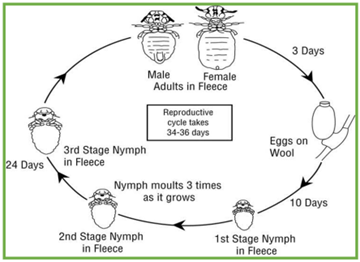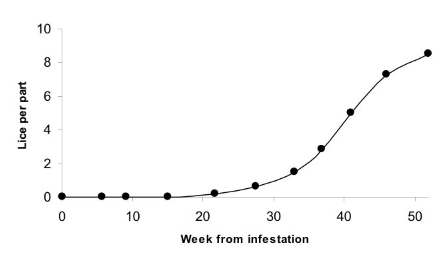Live Lice Free!
Adapted from Sheep Connect webinar presented by Jane Morrison
Sheep body lice, Bovicola ovis, cost sheep producers up to 1kg per head in clean wool cut and reduced yield returns due to yellowing and cotting of the fleece. To reduce the impact lice have on your production it is important to be up to date with the latest information about lice eradication.
Lice life cycle
Sheep body lice are host specific and can be transferred from one sheep to another via direct contact.
Lice require sheep skin cells to feed on and reproduce and in large numbers cause significant irritation to sheep.
The lice are very sensitive to changes in their environment, primarily temperature and humidity, and have a very slow life cycle which spans 35 days (see above image).
The female body lice will only lay 2 eggs every 3 days during this time. Based on the slow life cycle, in theory it is reasonable to think that sheep body lice could be eradicated quite easily, however statistics show 70% of properties will fail to eradicate lice with a single treatment. This high percentage is often due to incorrect management and treatment methods on farm.
Continual and complete treatment of all of the sheep on your property is key to eradication. It is recommended this treatment plan includes all of the sheep on your property and is carried out for 3 years from initial infestation.
Primarily, sheep become infected with lice via contact with new, introduced sheep such as rams or breeding stock bought at auction, as well as re-infestation from mistreated sheep or sheep that have not been treated at all that are already on the property.
Inspection tips:
Use good light and good eyesight
Inspect 10 rubbing sheep with 20 wool partings
Count the lice when you part the wool
Estimate timeframe for infestation – can take 2 to 6 months for population to build up to a level where sheep begin to rub so think about what was happening on farm 2 to 6 months prior (see below figure).
The above figure shows the typical pattern of lice infestation following the introduction of a lousy sheep. Note the gradual increase of lice numbers and time taken to become an obvious infestation.
Control methods:
Follow the instructions on the chemical labels – ensuring you treat 100% of the sheep on your property correctly as it only takes one mistreated animal to continue the infestation
Chemical treatment off shears or on short wool is the best method (<6 weeks) – ensure chemical application covers sheep from head to tail
Chemical treatment on long wool should be followed with another application of a different product after shearing
Treat all animals at the same time
Separate treated and untread sheep – never mix
Rotate chemical groups not chemical names
Pregnant sheep can be treated up until 6 weeks prior to lambing (always check your chemical label)
Assume any new or stray animals have lice and treat accordingly; quarantine and apply lice treatment
Plunge or cage dipping animals is the recommended method to ensure adequate chemical coverage
Some misunderstood facts about sheep body lice:
Lice infestations have no effect on fibre diameter, nor do they cause a reduction in body weight unless heavily infested. However, lice infestations do impact the quality of the wool.
Wool caught on fences is unlikely to be a source of infestation as most lice drop out of this wool within a few hours, as it lacks the correct environment and sheep skin cells.
Shedding breeds of sheep can get lice too
Spread of lice between mobs in adjacent paddocks does not occur readily unless sheep can get through the fences


